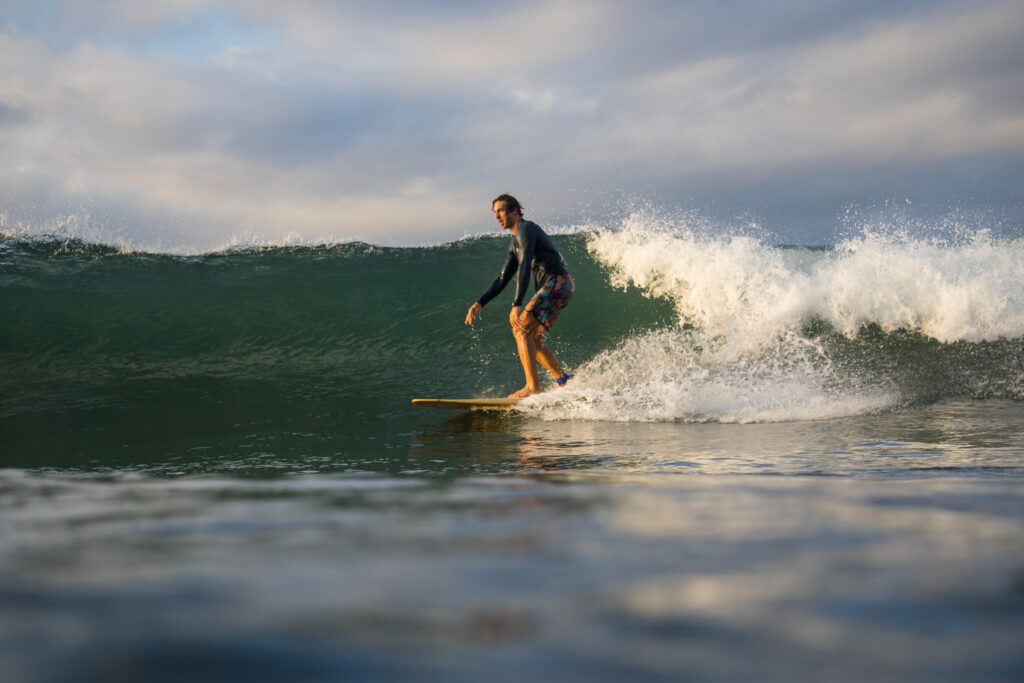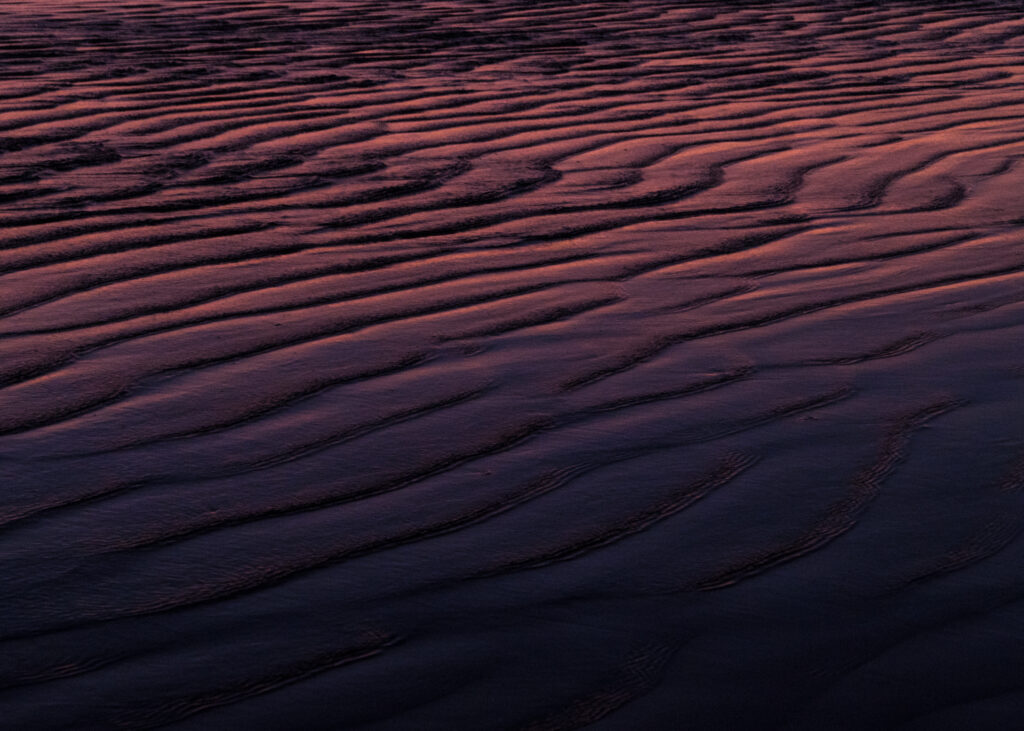Is Learning to Surf Hard? (Why We Believe It Doesn’t Have to Be)
Many consider surfing the most complex sport to learn, but this doesn’t mean that you can’t do it!
I learned to surf recently (very recently, actually, three months ago) at the start of my internship here at Bodhi Surf + Yoga.
Did I find it very hard at the beginning? Absolutely!
And three months on, I still find it challenging. But it’s so rewarding to look back at my surfing journey and see how far I’ve already come and how I’ve overcome so many of these challenges so early on.
A huge part of surfing is just being honest with yourself. Acknowledging that there are things that are difficult and that you need to work on. In this vein, it’s like many other sports.
So, what makes surfing different? No wave is the same.
An analogy that we like to use here at Bodhi Surf + Yoga is that a basketball player can stand there and shoot three-pointers from the same spot all day long and eventually perfect it.
With surfing, you will never find the same wave again. Ever.
You can learn to pop up perfectly on one wave and completely wipe out on the next. We’re talking a mouthful of water. There’s a pretty steep learning curve with surfing — whether it’s your first wave or you’ve been learning to surf for years.
Let’s discuss some things that most surf students find hard when learning to surf with us, why they’re hard, and how to overcome these difficulties.
📼 WATCH: Surfing doesn’t seem “hard” if taught the Bodhi way. If you want to get started learning to surf, check out our complete step-by-step series for beginners here:
👉 Check out the above video and more with our full series on learning how to surf.
What are the most challenging things about surfing?
From all our years of giving over 1,000 surfing lessons, the Bodhi Surf + Yoga team has a pretty good idea of what our students find hard about surfing.
What’s even better is that we’ve watched how our students overcome these challenges — and how you can, too!
So let’s get into it. What makes surfing hard?
Understanding the ocean
The more you surf and make it a hobby, the more types of conditions you’ll see.
Mother Ocean is a beautiful yet highly complex being. It’s almost as if she has her thoughts and feelings. Some days, she is calm, others rough. Some days, she welcomes us and gives us prime surfing conditions, and others, she doesn’t seem to want us to be there at all.
Because of this, we need to try our best to understand the varying surf conditions, the types, and the anatomy of waves and be able to decide whether or not they are conducive to surfing.
One way that we teach our students at Bodhi Surf + Yoga to do this is by completing a surf report. This allows you to analyze factors that influence surfing conditions and is a relatively basic and easy-to-learn way of reading the conditions for beginner surfers.
Knowing the location
This is another foolproof way of predicting the surf conditions before surfing. Even in the same conditions, different beaches and other surf spots have different waves and wave breaks.
For example, here in Bahia Ballena-Uvita, we know our local surf spots very well.
We know:
- How often do the tides change
- Which tides are better on each beach
- The typical wave conditions and their breaks
- The optimal waves for learning are from December-May
- How the weather conditions will likely affect the surf
Having this insight allows us to plan our lessons and their times accordingly. Essentially, we can tailor our lessons when we have them to suit the best wave conditions and the individual abilities of our students.
Better yet, having this knowledge of our local surf spots allows us to use each one for its strengths rather than relying on just one beach to be perfect.
Check out our favorite surf spot for our surfing retreats here in Uvita!
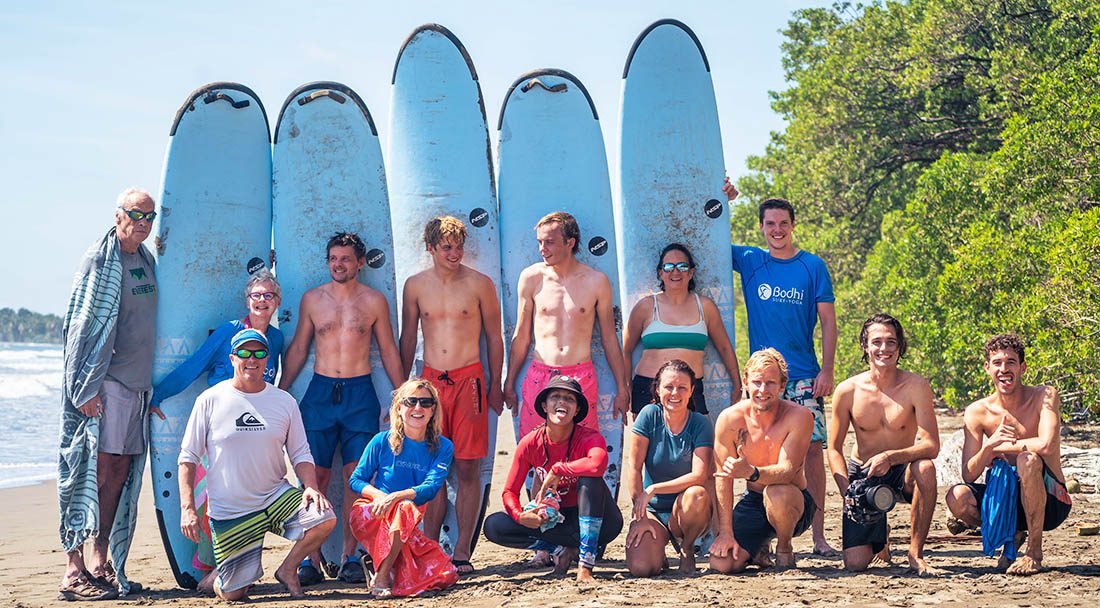
Selecting the right equipment
We really wish surfing was as easy as grabbing a board and heading out into the waves; unfortunately, it’s not.
At Bodhi Surf + Yoga, these are the pieces of equipment that we ensure match the abilities and meet the needs of each of our students:
Surfboards
Picking the right or wrong surfboard can be the difference between you absolutely crushing it out there and coming back extremely frustrated after not catching any waves at all.
The type of surfboard you use depends on your ability level.
For beginner surfboards, we recommend:
- Longboards
- Funboards
- Softboards
These surfboards are generally longer, wide, and round and have thick rails, giving them more volume. These characteristics make the surfboard more buoyant and stable. Perfect if you’re a beginner surfer trying to catch your first wave.
As you become a more advanced surfer and want to learn more skills, you can move on to thinner and smaller surfboards that allow for tighter, more agile turns and speed.
Fins
Like the different types of surfboards, different fin configurations have different purposes for surfing. Using the wrong fins for your level or surfboard will make surfing feel more challenging than it needs to.
Our surf instructors usually give our students just learning to surfboard with the thruster setup (three fins). But other setups for beginners include:
- Single fins
- Twin fins
- Quad fins
These configurations are better for beginners as they allow your surfboard to have ample stability control and are usually better for catching smaller waves.
These are the perfect characteristics for when you’re just learning the ropes and perfecting popping up and catching white water waves!
Again, like with surfboards, as you become a better surfer, you can try out different fin configurations on different boards. Another big part of surfing is experimenting!
You may fall off a fair few times in the process, but if you ask us, that’s the best way to learn!
Learning proper surfing technique
Believe it or not, you can be using the incorrect surfing technique before you’ve even reached the water!
Learning the proper surfing technique starts when you’re on the sand on the beach and ends there again after you’ve finished surfing.
We’ll walk you through every one of the proper forms of technique that we teach our surfing students at one of our retreats, from lesson one through five!
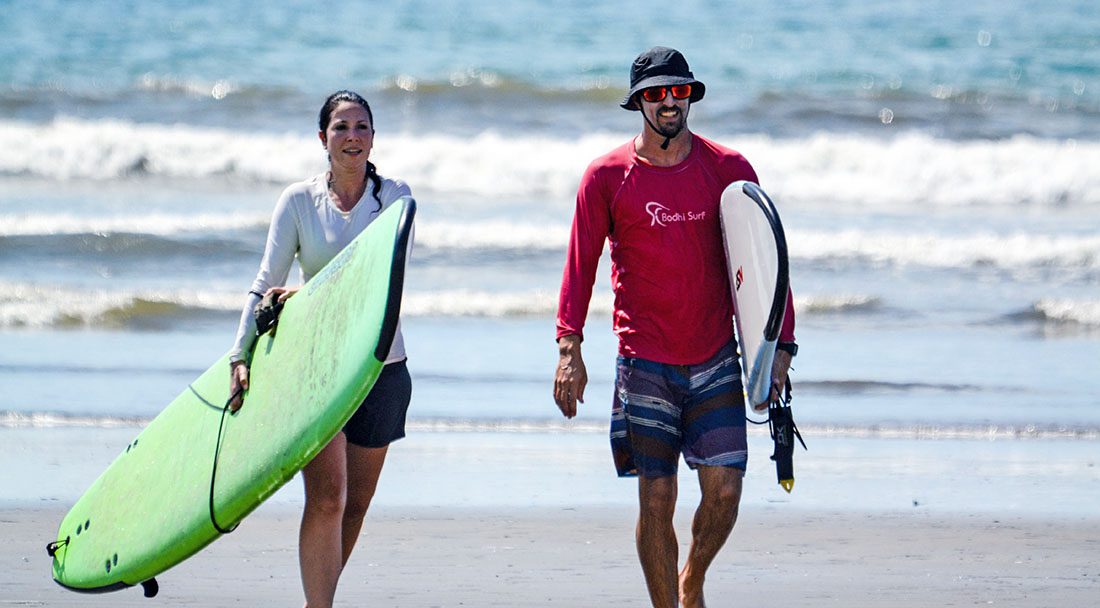
Attaching the leash
Yes, even this can be done wrong!
You want to attach the leash tightly to the leash plug on the tail of your surfboard. Easy enough, right?
What we see a lot of people do wrong is what comes next. We encourage our students not to attach the other end of the leash to their ankles. We suggest walking with the board down just before the shoreline, holding the other end of the leash with your hand.
Why? You wouldn’t believe how often people have tripped over their leashes while walking their boards to the water.
Imagine going down to the water, just raring to get out there. You’re picturing yourself in slow motion, walking elegantly like one of those excellent surfer dudes/dudettes you’ve seen on TV, and the next thing you know, you’re face down in the sand.
Trust us, even if it might be a little funny, we don’t want that for our students.
When you’ve reached the shoreline, put your board down and attach the leash to your dominant foot, with the swivel pointing behind your ankle. Embarrassment-free!
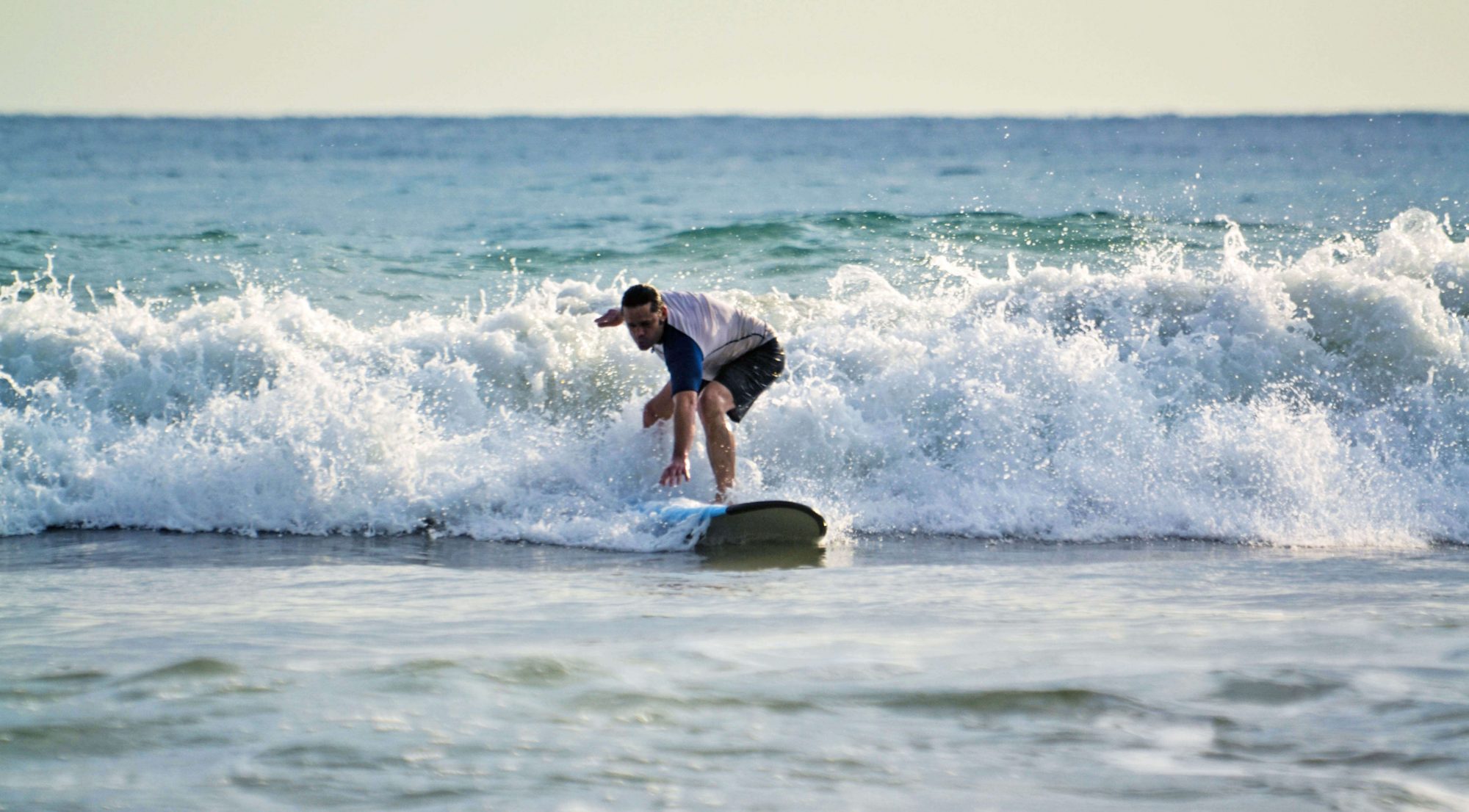
Catching whitewater waves
One of the first things we teach our students in the first lesson of their retreat is how to catch white water waves.
You’ll probably hear your surf instructor refer to “the whitewater” area of the water, where the waves have already broken.
The whitewater is the perfect place to learn the techniques that will help you later on in the lineup when you’re catching blue-green waves — so essentially, this is one of the most essential parts of your lesson!
During your first surf lesson with us at Bodhi Surf + Yoga, we’ll teach you the theory back on the sand. Travis (co-owner and surf instructor) is known to get pretty creative and artistic with it.
After watching Travis roll around in the sand for a bit, we’ll go into the white water and try to put some of this theory into practice:
- Line yourself up to be perpendicular to the oncoming wave
If you’re at an angle, the wave might push you over! Lining up the tail of your board with the wave will put you in the perfect position to catch it cleanly, and you’ll be able to maintain your balance. - Paddle away from the wave.
You don’t want to catch the wave too soon; it won’t be tall or strong enough and will just roll under you. To catch the wave at the right stage, we teach our students to paddle for the wave (towards the beach), while continuously looking back to track the wave’s movement. If you’ve timed it right, you can catch the wave at the correct stage. - Smile while you paddle.
This has become a slogan here at Bodhi Surf + Yoga. Smiling helps you subconsciously be happy, helping you keep a positive attitude while surfing. Interesting right? We’ll talk more about this later. - Look ahead
You mustn’t just stare down at your feet while surfing; look where you’re going! We tell our students that “you’ll go where you’re looking,” so if you’re staring down, that’s most likely where you’ll end up going! Another analogy that our surf instructors like to use here at Bodhi Surf + Yoga is that of riding a bicycle. When doing this, you always look ahead at where you’re going, not down at the handlebars or the pedals.
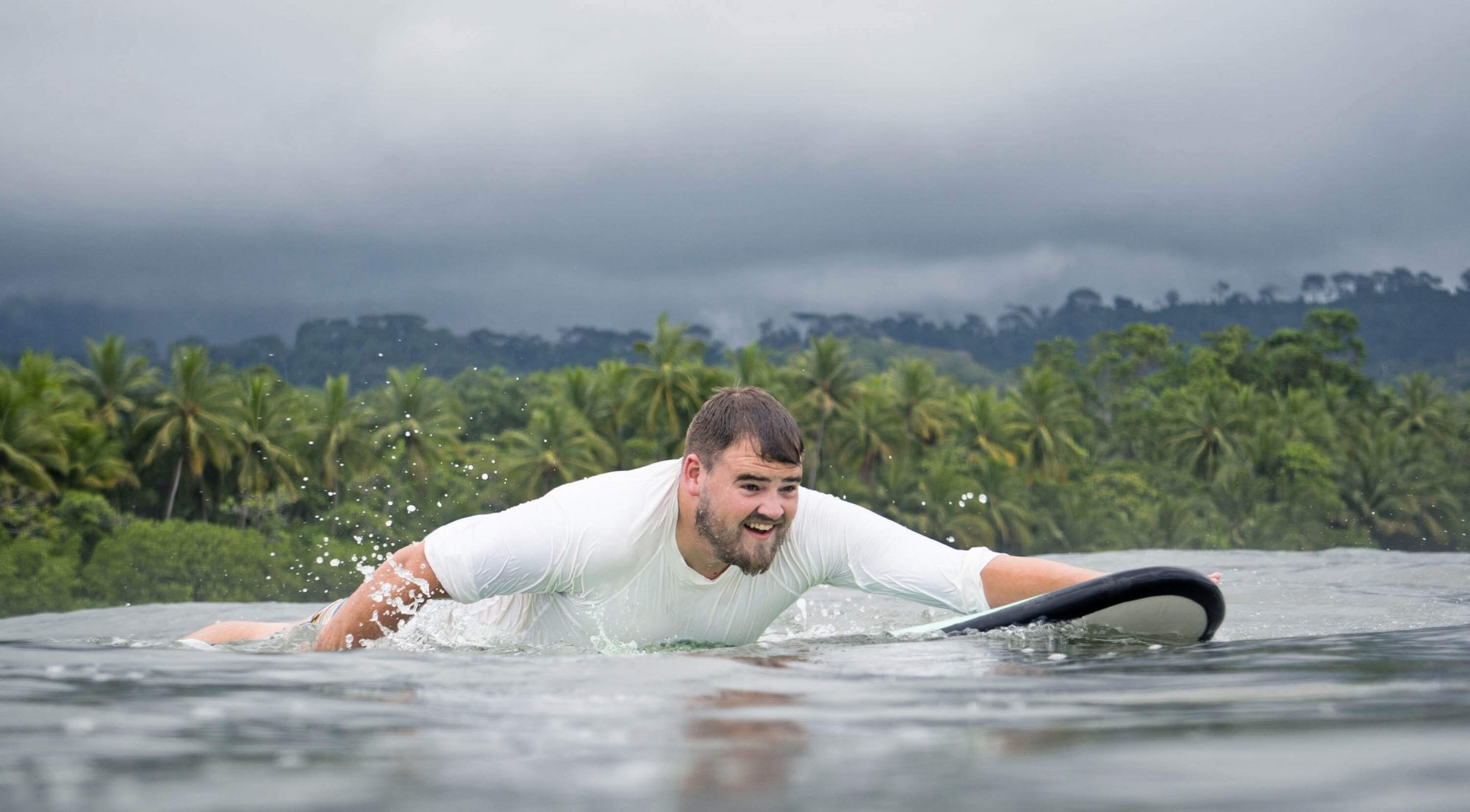
Paddling out
Many people will tell you that this is the hardest part of surfing.
Depending on the conditions, paddling out can be a walk in the park or feel like the most intense workout you’ve ever done.
How easy it is for you depends on your surfing experience level and ability. At our surf camps, we have people who manage to paddle out to the lineup after the first lesson and others not until the last lesson of the week.
Either way, you can make paddling out easier by learning the correct technique.
Remember earlier when we talked about counting the waves in each set and how long the period lasts? This is where that comes in handy.
We encourage our students to sit for at least 10 minutes before they enter the water. Just watching the waves and looking for the best time and place to enter the water to paddle out.
Think about it: would you rather paddle out during a calm period of no oncoming waves or while Mother Ocean is throwing toward you absolutely everything she’s got? We know which we prefer…
You might wonder, “How can I paddle quickly and efficiently without burning myself out?”
We’re glad you asked. As you might have guessed, there’s a technique for that, too.
When paddling, you want to remember to:
- Use your whole arm. You should paddle with your hand to your elbow underwater, allowing you to push more water and propel yourself further.
- Position yourself correctly on the surfboard. Where on the board depends on which size you are and how tall you are, but having your weight too far up or down the board can make paddling harder. Generally, you want to have your toes near the surfboard’s tail.
- Keep your chest up and shoulders back, as opposed to lying flat on the surfboard. This gives you a better view of oncoming waves and other surfers around you.
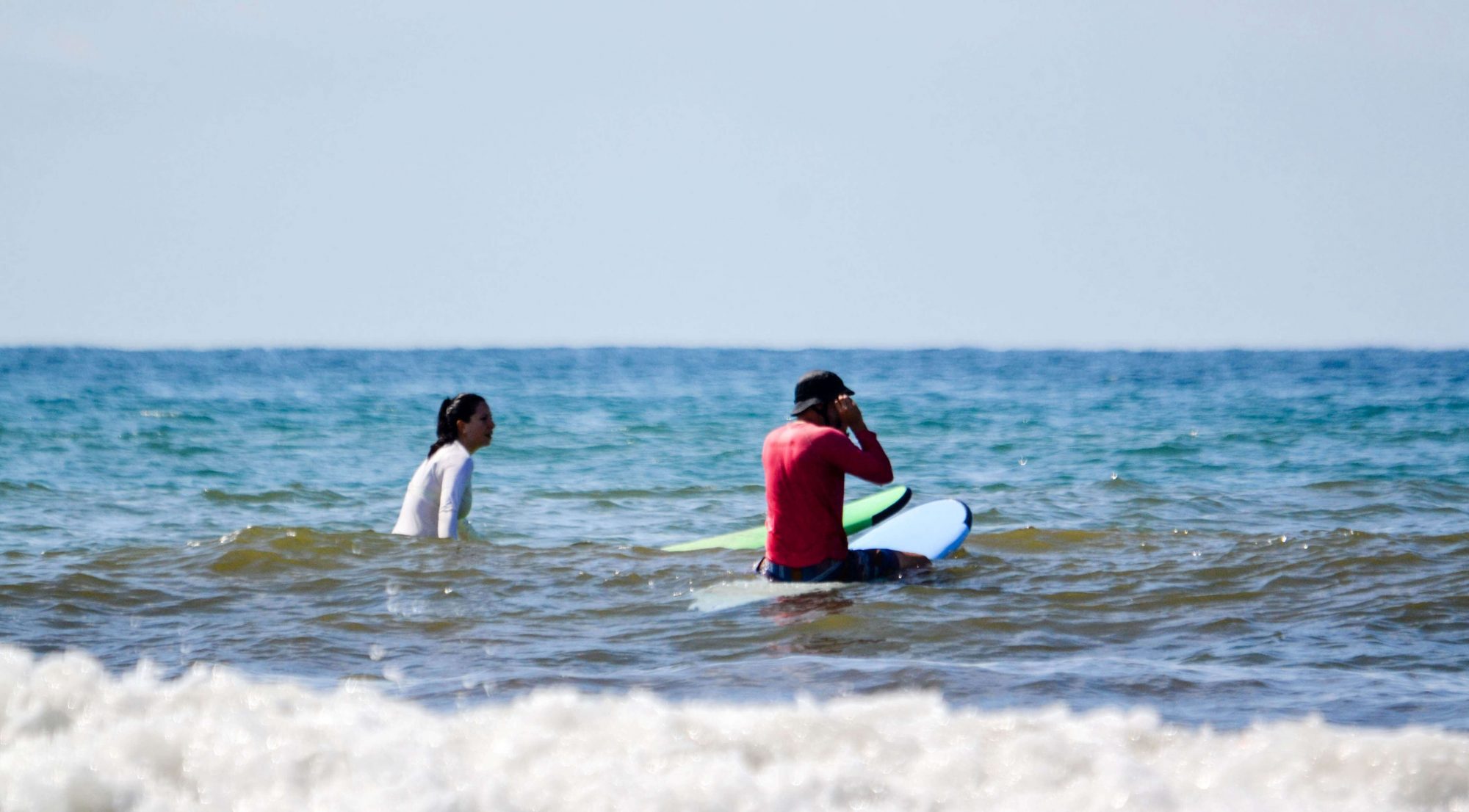
Sitting out in the lineup
You’ve paddled out and made it to the lineup!
At this point in your lesson, you’re probably in need of a breather. You’ve earned it. We know it’s not easy paddling out and getting through the big wave sets.
All that’s on your mind now is probably a giant plate of food and an ice-cold cerveza. But wait! This is the fun part.
Out in the lineup, you can sit on your board and catch your breath while watching the horizon for potential bumps.
Now, although this is the part where you actually get to channel your inner Instagram surfer dude and look super cool riding blue-green waves, it’s also where technique is vital.
Imagine you’ve paddled out and fought through what feels like monstrous sets. You’ve waited your turn in the lineup. You’ve tracked a wave, started paddling for it, and tried to get to your feet. And the next thing you know, you’re doing cartwheels underwater because you’ve fallen off immediately, and the wave has broken on you.
All that hard work… for nothing!
This happens to everyone. However, by applying the proper technique, you can actually catch the wave rather than the scenario we just walked through.
Here’s what we teach our surf students to do out in the lineup:
- Sit on your board
Sit towards the back of your surfboard and lean forward to avoid falling backward. This allows you to have a much better view of the waves popping up on the horizon than you would do if you were still laying on your board. - Spin around
When it’s your turn, and you’ve tracked a wave from the horizon while still sitting, turn around on your board. Sitting towards the back of your board also helps you pivot and spin around quicker - Lay down and paddle
Once you’ve turned around, lay back down and start paddling away from the wave while looking back over your shoulder to track the wave. You want to monitor the wave’s speed and which direction it will break. Paddling too fast will cause the wave to break on you, and too slow will mean you miss the wave altogether. One final step — paddle a bit in the direction the wave is breaking. While doing this, paddle faster as the wave gets closer to you. For example, if the wave is breaking to your right, paddle towards that direction. This will help you catch the blue-green part of the wave rather than the whitewater part, which has already broken. - Catch the wave!
Finally, everyone’s favorite part! First step: relax. Don’t panic; you’ll lose focus, and you may lose the wave! Once you’re on the wave (still paddling) and your board starts to angle down the sloped face of the wave, that’s when you want to get to your feet.Here, just stay calm and remember what you learned in the white water:
- Place your hands on the board and pop yourself up
- Remember not to grip the rails — place your hands on top of the surfboard, sort of like a pushup position
- Look where you’re going — not down at your feet
- SMILE!
Leaving the ocean
Here, you basically want to do step one in reverse.
At the shoreline, unattach the leash from your ankle and carry it back up the beach.
Remember what we said about walking with the leash on? You don’t want to end an epic day of surfing by tripping over your leash in front of everyone!
No matter how many gnarly waves you caught that day, this will be what everyone remembers!
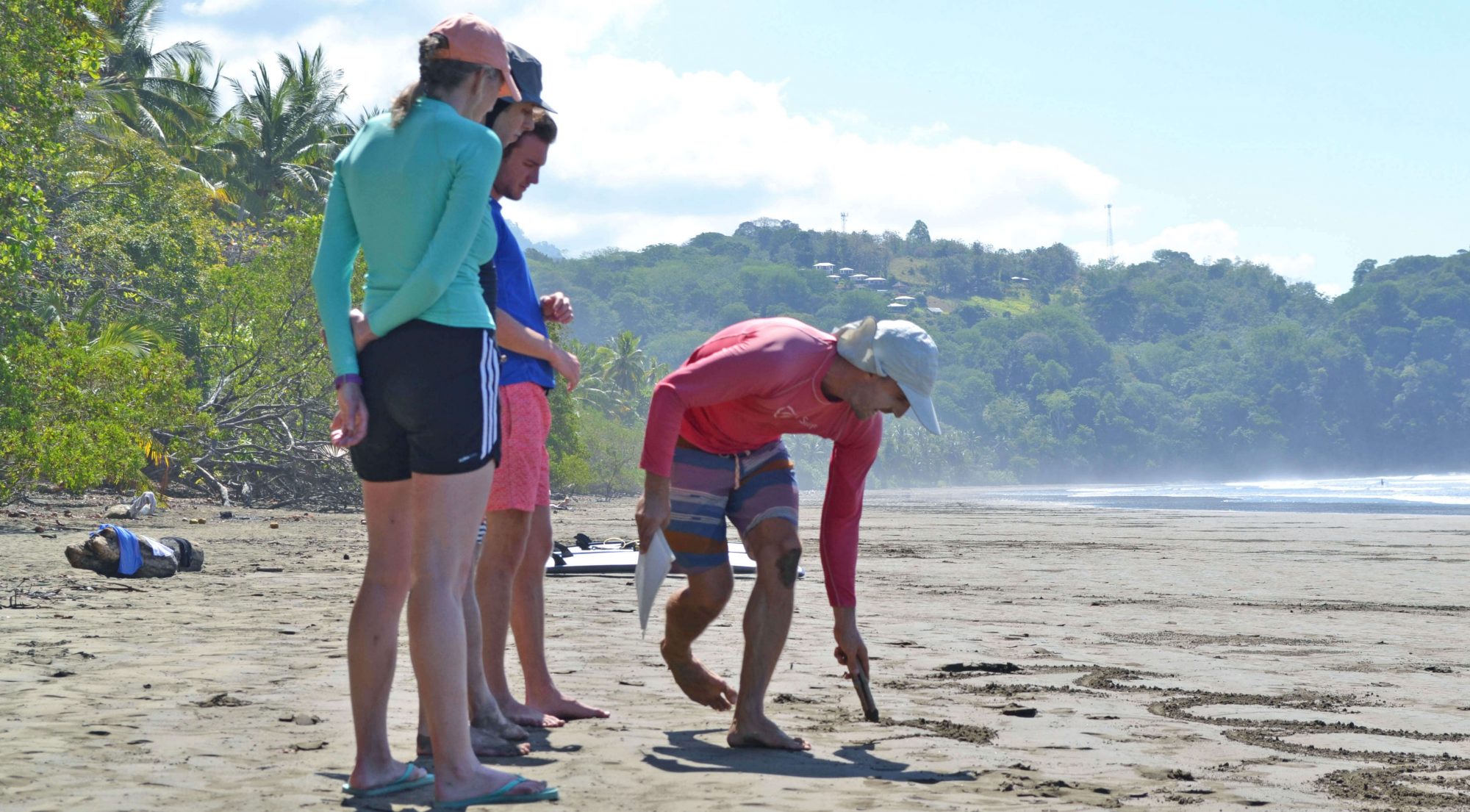
Learning the rules of the game
A less physical and more theoretical aspect of surfing that can be challenging is learning the surfing rules and etiquette.
It’s all good knowing how to surf and being able to catch waves, but just like any other sport, you’re not playing correctly if you aren’t following the rules.
Think about it: you wouldn’t run out on a football pitch without knowing how to play, right?
Learning these rules will simplify surfing and give you a better experience! As a beginner surfer, you’ll gain so much respect from the other surfers if you try to learn surfing etiquette.
The last thing we want is for our students to get an earful from other surfers for not following the rules, so a considerable part of our lessons at Bodhi Surf + Yoga involves rules and etiquette.
The most common rules that we teach our students involve:
- Paddling out
- Right of way
- Dropping in
- Snaking
In our Surf Etiquette blog, we go into a lot of detail about each of these things: what to do if you’re dropped in on or snaked, and what to do if you find yourself mistakenly doing it to someone else!
Once you understand these rules, following them is pretty straightforward.
At Bodhi Surf + Yoga, we strongly believe in the power and benefits of taking surf lessons. To us, it’s the best way to learn all these things you might not have even known you should know!
We are highly committed to producing knowledgeable surfers passionate about the sport, and teaching these rules is a massive part of how we do that.
The physical challenge
One of the most common questions we get here from potential guests and students is, “Am I fit enough to surf?”
We’re glad to tell you over the years, we’ve taught many people to surf. Your age, height, and weight do not matter.
We’ve taught young children, adults, and elderly people of all different heights and sizes.
If you want to learn to surf, you can. You just have to be dedicated and understand that irrespective of any of these things, there are some physical challenges.
In this aspect, the question of “Is surfing hard?” is best answered by Yvon Chouinard — Patagonia owner and environmentalist:
“It’s not like getting back on a bicycle… you spend thirty seconds on your feet a day as a beginner… try learning anything else at thirty-seconds-a-day intervals.”
Let’s look at some physical aspects that make surfing hard and how we at Bodhi Surf + Yoga help our students overcome them.
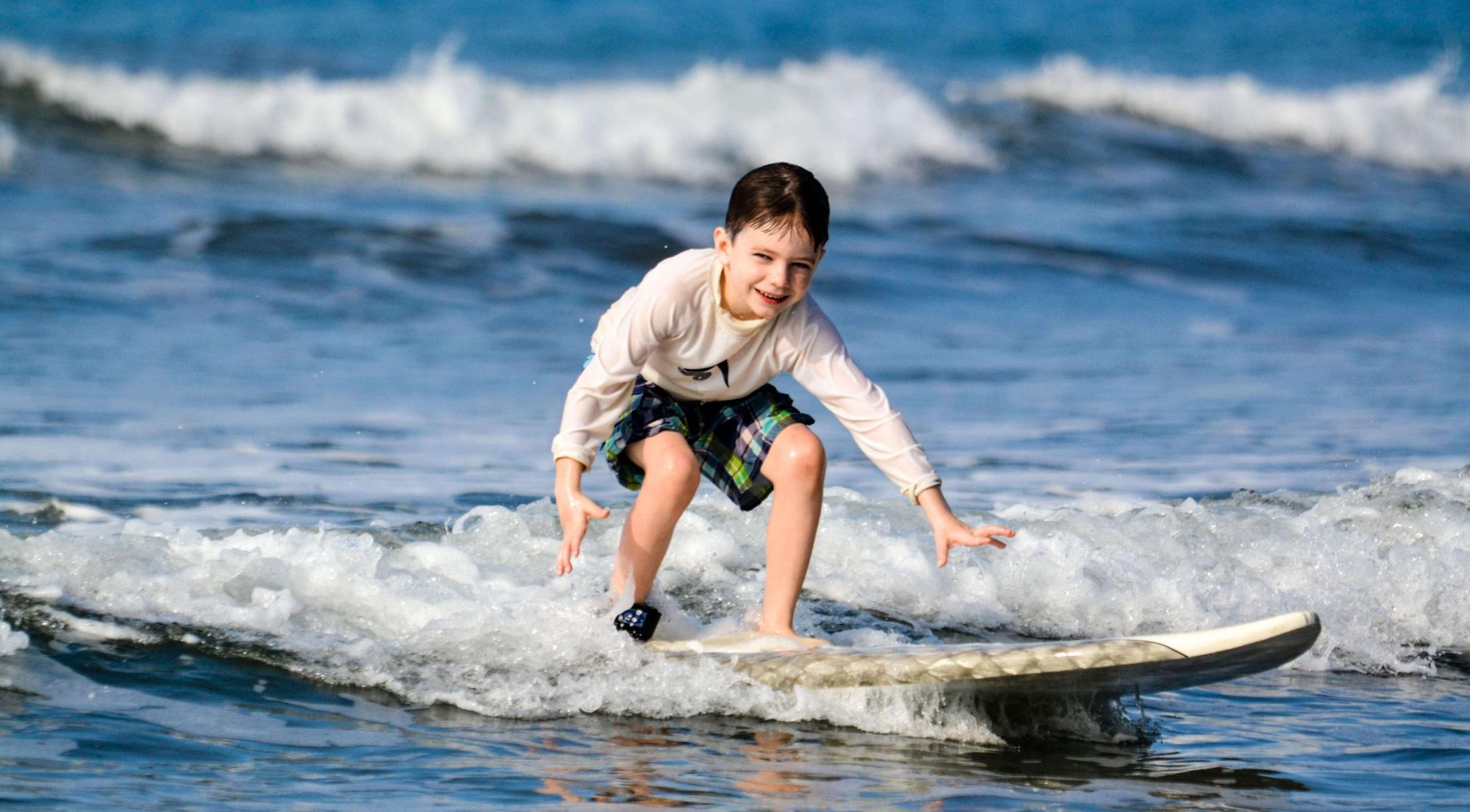
Learning to surf in the whitewater
As we said earlier, the whitewater is where the fundamentals of surfing are learned. We encourage our students not to paddle out until they are confident with their ability in the whitewater.
Surfing in the whitewater isn’t the most physically challenging part of surfing, but that doesn’t mean it’s easy.
If it’s your first time learning to pop up on your surfboard, it can be a very tiring and repetitive process. If you think about it, you’re using your muscles like they’re not used to.
It takes time to work up that muscle memory.
Do we have our own Bodhi Surf + Yoga way of helping our students with this? Of course, we do!
A lot of the time, our surf instructors will draw surfboards on the sand, and — yes, you guessed it, our students will practice “popping up” lying down on the sand.
As funny as this may sound, it works!
It’s much easier to transfer this practice into the whitewater and perfect it there.
You don’t teach surfing lessons for as long as we have without picking up a few tricks!
Watching surfing videos on YouTube is another excellent way of learning and practicing without being on the beach. At our surf camps, it’s very common for our surf instructors to send links to helpful videos in the weekly WhatsApp group chats.
We know no one loves homework, but it could be worse, right?
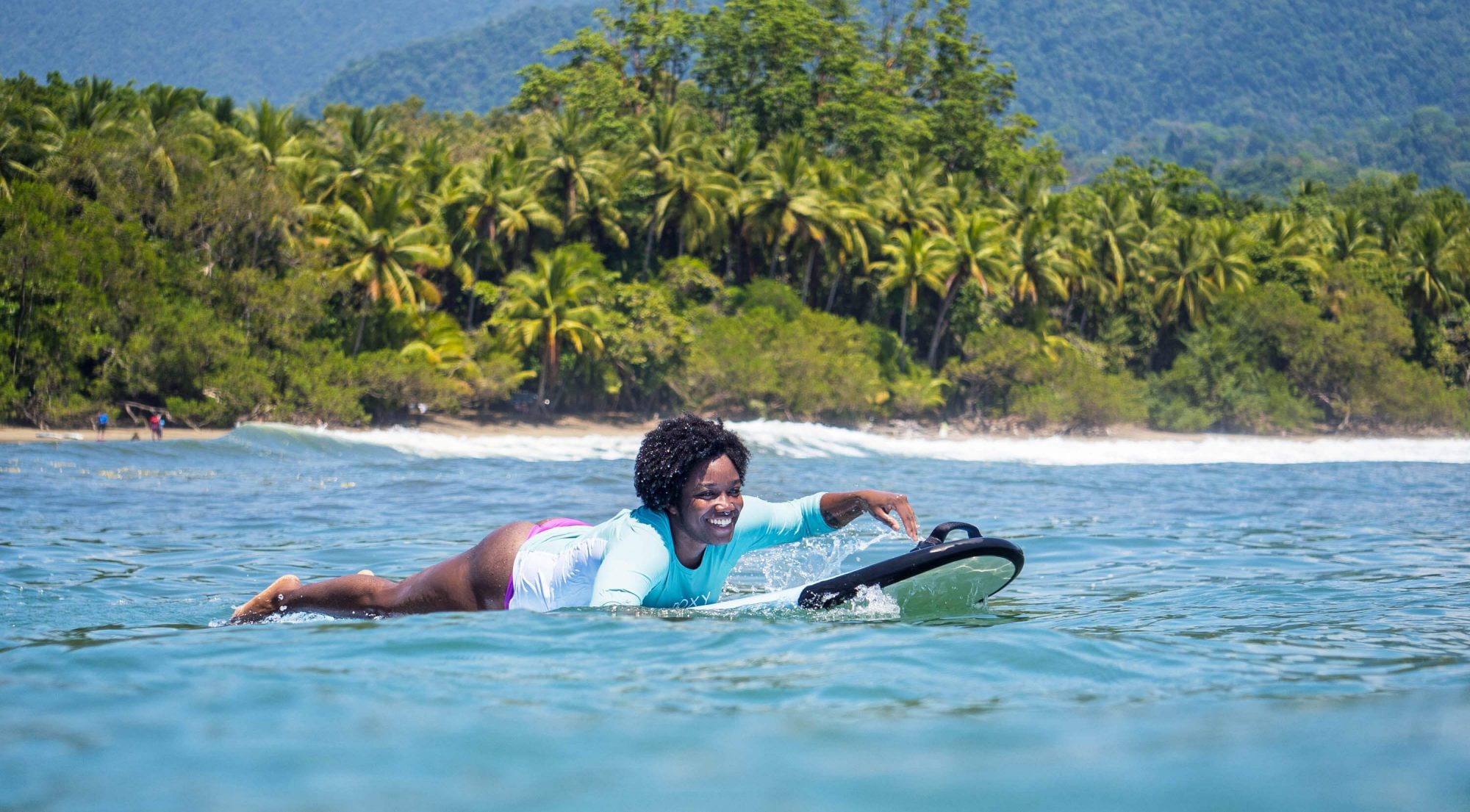
Learning to paddle out
Now this — this is where your body gets upset with you.
Paddling out can be a physically rewarding experience, but sometimes, the ocean makes you WORK for it.
First of all, it can be a killer workout for the arms. It’s made a bit easier by following the proper technique that we talked about earlier, but sometimes the waves are strong, and there’s little time between them, so there’s no avoiding it. It’s a part of surfing!
Another challenging part of paddling out is stamina.
If you’re in a break between wave sets, you must paddle as hard as possible before the waves start coming at you again. Depending on the day, you may have less than a minute to paddle from the whitewater to the lineup.
Why does this make surfing hard?
If you get tired after 30 seconds of intense paddling, you don’t really have the time to stop and take a break. If you do, the next set of waves will start pushing you back, and it only gets more complicated from here.
You can prepare for these physical challenges by watching our YouTube video on getting in shape for your tropical vacation.
After your first day of surfing, you’ll feel your body like you’ve never felt it before. Way to make you feel alive, right?
At Bodhi Surf + Yoga, we have a remedy for this for our guests who are staying with us:
- A delicious dinner
- Tropical cocktails (and lots of them)
- Amazing company and laughs
- Yoga and massages
Keeping in shape between sessions
The easiest way to get in shape is to keep in shape. Agreed?
At our surf retreats here at Bodhi Surf + Yoga, our guests are constantly being active with:
- Our Community Walking Tour
- Daily surf classes
- Daily yoga
- A waterfall visit
Because of this, our guests can stay in shape and keep their bodies engaged between surf classes. This is another massive benefit of surfing.
For others, however, it may be difficult to maintain their shape between sessions.
One thing that we can’t recommend enough is yoga!
This doesn’t have to mean staying at a week-long yoga retreat; you can do yoga from the comfort of your own home or garden with our Bodhi Online Membership!
Yoga is highly beneficial for beginner surfers for stretching your muscles out and awakening your body, and some of the poses will directly help you on the surfboard.
This will give you a little taste of what you can experience at one of our surf and yoga retreats!
How to breathe properly
This is one of the most important parts of surfing, especially while paddling out.
So, therefore, it’s one of the things that makes surfing hard for beginners if they’re not doing it correctly.
You might be thinking, Breathing? How hard can that be?
It doesn’t sound very challenging. I mean, we do it every day without even noticing it.
Well, let us tell you. When you’re paddling out, you notice it.
Breathing correctly can be the difference between making it out to the lineup and crushing it, or exhausting yourself and having a tough time out there.
The first thing we recommend? Taking long, deep breaths. This is also referred to as Pranayama breathing.
Pilar has a blog on the benefits of Pranayama breathing that’s worth checking out!
Another thing to avoid — over-breathing.
Think about how you breathe when you’re having a panic attack — your inhales and exhales are very fast. There’s no way your lungs can get enough oxygen from this, so you’ll end up completely exhausting yourself.
So remember, if you get to the point where you’re breathing quickly and getting tired — take some deep breaths and focus on breathing correctly.
And to be honest, we tell many of our students that if you’re really that tired and short of breath, it’s probably best to turn around and come in for a rest.
The mental challenge
The mental side of surfing isn’t talked about anywhere near as much as the physical side — yet it is just as important.
At Bodhi Surf + Yoga, from our years of helping people surf, we understand that sometimes beginner surfers struggle even more with the mental side of surfing than the physical.
This is another reason we believe strongly in surfing lessons rather than attempting to self-teach. If you’ve ever surfed before, you know for sure that it can be stressful, frustrating, and anxious… but it can also help with your anxiety.
By taking a lesson or two, you:
- Are in a supportive learning environment
- Are surrounded by others with the same experience level
- Learn rules and etiquettes that you would not by self-teaching
- Connect with other surfers
- Are allowed to make mistakes
This takes a load of those mental challenges off your shoulders and allows you to focus on your surfing and your enjoyment.
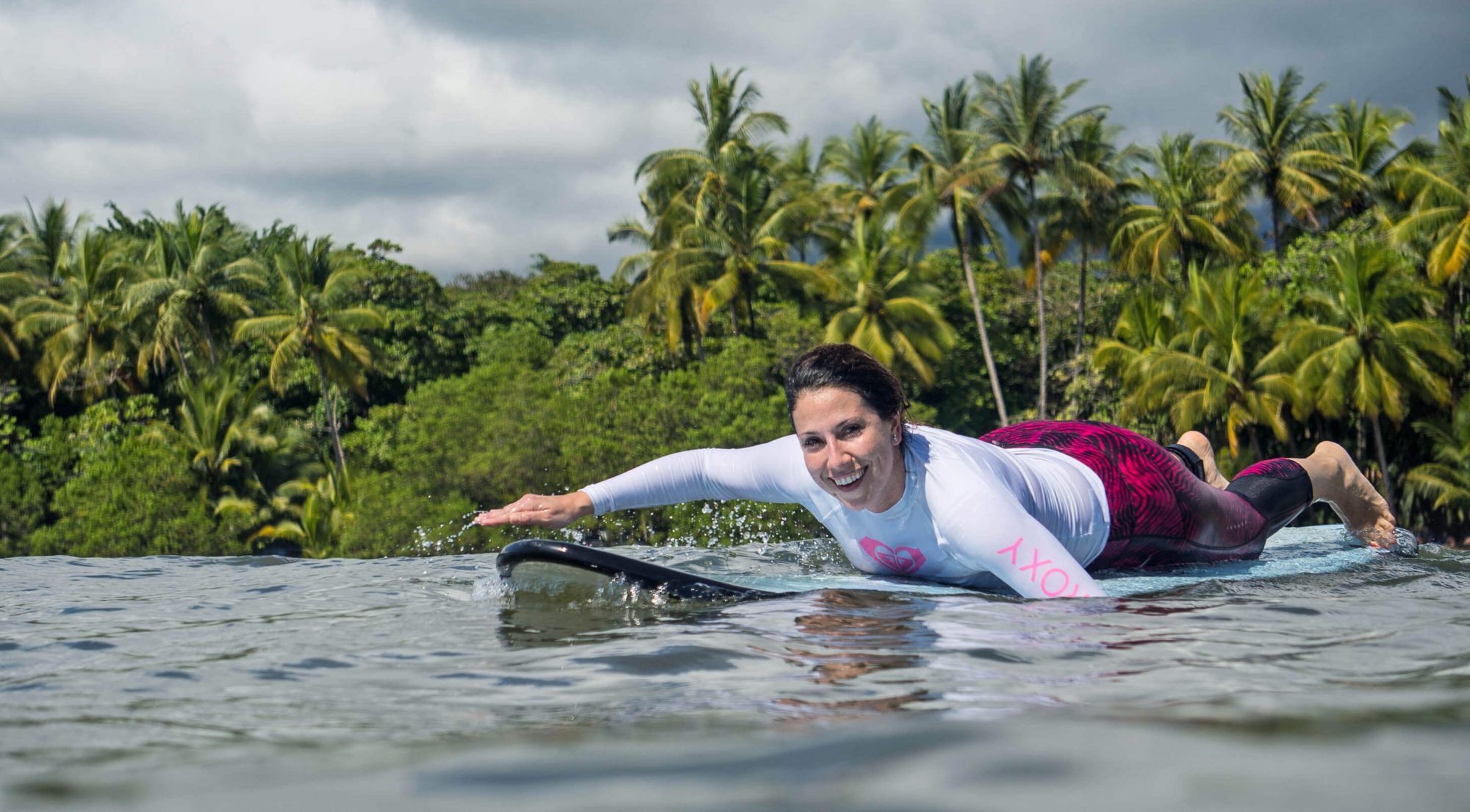
Smile through the mental and physical challenges.
It’s not a complete surf camp with us here at Bodhi Surf + Yoga if you haven’t heard our favorite saying: “Smile while you paddle,” at least once daily.
What can we say? We love it!
But what does it mean, and why do we say it? How does it make surfing easier?
Here’s how. Try this.
Wherever you’re reading this blog right now, whether at home, work, the bus stop, or wherever — smile, just take five seconds to smile, even if it’s just to your phone.
How does that feel?
Don’t you automatically feel happier or more at ease, even if it’s just a little?
A simple smile can actually influence your mood — it triggers dopamine and serotonin, which boost your mood. This helps you stay focused and positive and lowers your blood pressure, helping you stay calm and relieve stress.
Did you know that one smile can generate the same brain stimulation as 2,000 bars of chocolate?
So, what’s the story behind this here at Bodhi Surf + Yoga?
It started when a past guest of ours (now a return guest) was struggling to stand up on her surfboard. Understandably, she was getting frustrated.
Travis noticed this and told her she should smile while paddling for the wave, which she did, and then described that she felt the following…
“An overwhelming sense of calmness, felt collected, and happier in that stressful situation.”
Of course, what happened next is that she could stand up on the wave!
Travis explains the following:
“Trying to catch a wave can be a challenging and stressful moment. If we don’t smile, we’re sending stress signals to the brain.
When you enter the water you want to be calm, cool and collected.
If you’re grinding your teeth and looking angry while paddling for the wave, you’re sending negative messages to your brain and body which will make you tighten up.”
Essentially, when surfing, you want to be loose and at ease. You will find it much harder to surf if your body is tight and stiff.
About 70% of surfing is paddling — we might as well make it as enjoyable as possible.
We can also view smile while you paddle as a metaphor for life. When challenges arise, if you can learn to smile through them — even if you’re faking it, you can make a difficult situation more pleasant and easy to deal with.
Our guests and surf students have taken to this saying so much that we are in the process of patenting it and are soon to be launching our Smile While You Paddle brand.
So be sure to keep your eyes peeled for that!
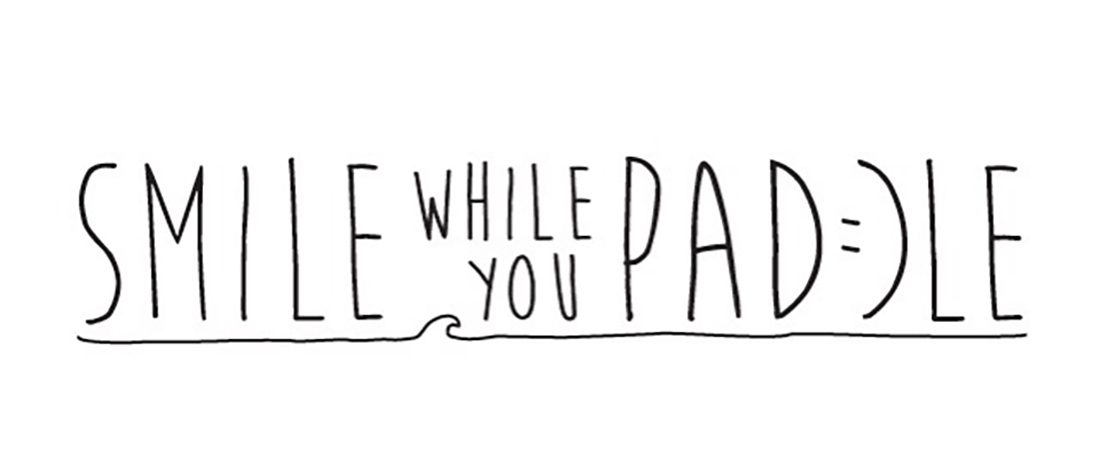
Learning to surf can be difficult, but it’s worth it
As you already know, if you’ve ever surfed and fought through these difficulties, it’s totally worth it.
Might you get a little beaten up? Yes.
Tired and sore? Even more of a yes.
But being out in the ocean catching waves is one of the most fulfilling and awakening experiences you can give yourself.
You’ll learn so much about your strengths and abilities; you’ll develop a connection with yourself and nature that you’ve probably never had before.
So, to answer the question of is surfing hard? Yes.
But is it worth it? Yes.
Can you learn it and get better at it? Absolutely!
You don’t have to take it from us; take it from our guests:
“The surf instruction is excellent. During our first trip I went from never having surfed to riding green waves in the first week and have since spent all my time outside the white wash. That was very gratifying.”
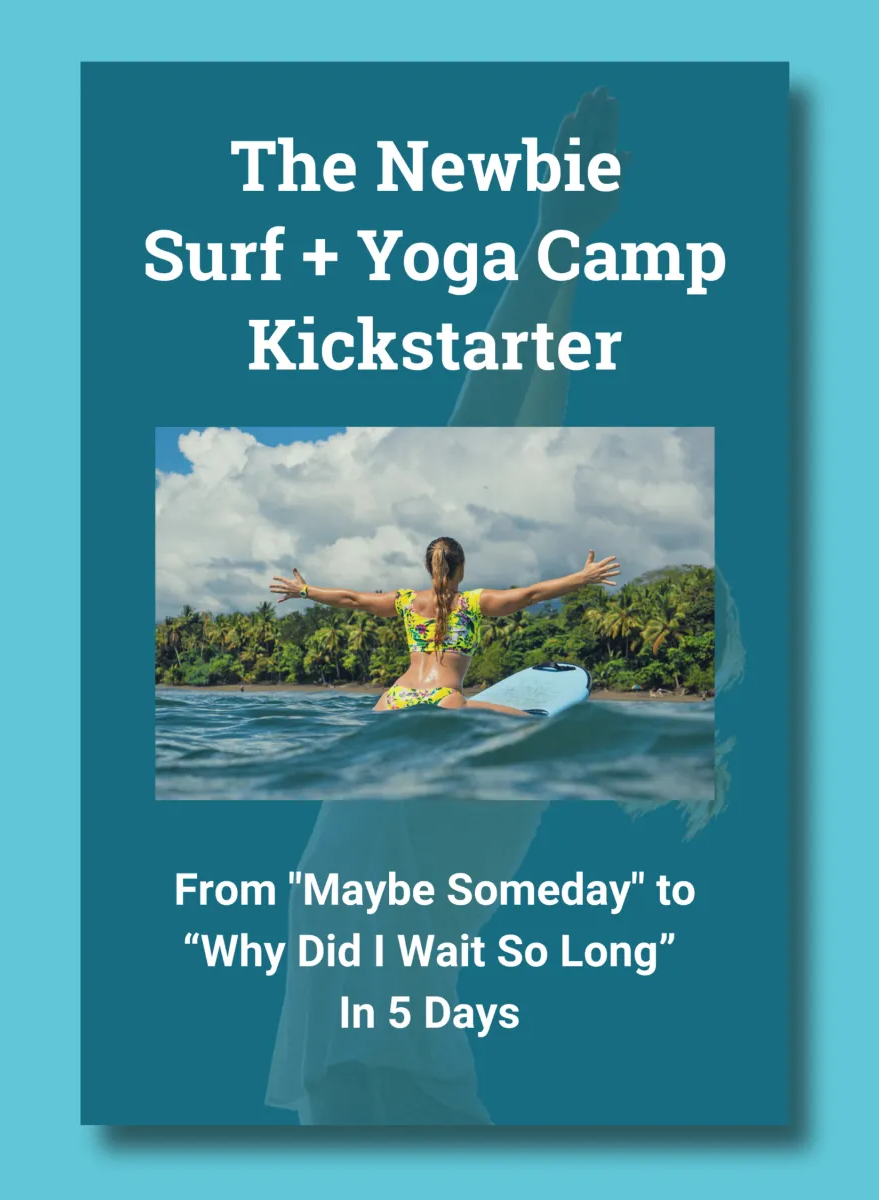
For First-Time Surfers
You Don't Need Experience. You Don't Need Gear. You Just Need This.
Our free 5-day email course that reveals the 5 myths keeping beginners at "I'm not ready" instead of catching their first wave and finding inner peace-and how to overcome them fast.
Change the heading on the Separator tab ->
Search
The Newbie Surf + Yoga Camp Kickstarter
Bust the 5 biggest myths about going to a surf and yoga camp so you can stop procrastinating and start catching waves - with our FREE 5-day email course.
Change the heading on the Separator tab ->
Most Read Blogs
What is the Meaning of Anjali Mudra?
May 27, 2020
Fitness for Surfers: Workouts, Exercises & Training
February 10, 2022
The Best Places to Eat in Uvita, Costa Rica
May 19, 2022
How to Get From SJO to Costa Ballena, Costa Rica
May 31, 2018
Change the heading on the Separator tab ->
Categories
Categories
- Bodysurfing (5)
- Food (8)
- Responsible Business (6)
- Surfing (66)
- Travel (65)
- Yoga (44)
Change the heading on the Separator tab ->
Newsletter
Thanks for subscribing! Please check your email for further instructions.
Change the heading on the Separator tab ->
Follow Us
George Frost
Change the heading on the Separator tab ->
Read more
5 Reasons Why a Surf + Yoga Retreat Should Be Your Next Big Bucket List Adventure
Words by Travis
If you’re reading this, chances are you’re experiencing a little restlessness. You’ve scrolled past the passive beach vacations and you know, deep down, that your next trip needs to be different. It…
Small Things That Make A Big Difference to Progressing Your Surfing
Words by Guest Post
Welcome to the first of our three-part series covering the small things that make a big difference to your surfing! You are most likely reading this because you’ve taken some surf lessons…
Sandbars for Surfers: Everything You Need to Know and More
Words by Guest Post
Ever wonder what a sandbar is? When it’s low tide you can see them, but what happens when the ocean covers them? Most surfers may just look at the waves on the…


